Experimental task 1
The source code of task1 is as follows:
1 assume cs:code, ds:data 2 3 data segment 4 x db 1, 9, 3 5 len1 equ $ - x 6 7 y dw 1, 9, 3 8 len2 equ $ - y 9 data ends 10 11 code segment 12 start: 13 mov ax, data 14 mov ds, ax 15 16 mov si, offset x 17 mov cx, len1 18 mov ah, 2 19 s1: 20 mov dl, [si] 21 or dl, 30h 22 int 21h 23 24 mov dl, ' ' 25 int 21h 26 27 inc si 28 loop s1 29 30 mov ah, 2 31 mov dl, 0ah 32 int 21h 33 34 mov si, offset y 35 mov cx, len2/2 36 mov ah, 2 37 s2: 38 mov dx, [si] 39 or dl, 30h 40 int 21h 41 42 mov dl, ' ' 43 int 21h 44 45 add si, 2 46 loop s2 47 48 mov ah, 4ch 49 int 21h 50 code ends 51 end start
The screenshot of the operation result is as follows:
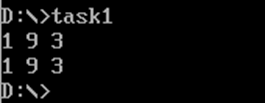
Question answer:
① Q: when the line27 assembly instruction loop s1 jumps, it jumps according to the displacement. Check the machine code through debug disassembly and analyze the jump displacement? (the displacement value is answered in decimal) from the perspective of the CPU, explain how to calculate the offset address of the instruction after the jump label s1.
A: check the screenshot of the corresponding machine code through debug disassembly as follows:
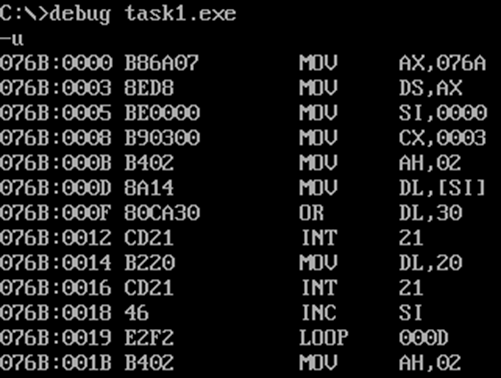
As can be seen from the figure, the jump displacement of the loop s1 instruction is - 14, which is obtained by subtracting the first byte address (i.e. 076b: 001b) after the loop s1 instruction from the address (i.e. 076b: 000d) at the s1 label. For the CPU, the displacement is expressed in the form of complement.
② Q: line44, when the assembly instruction loop s2 jumps, it jumps according to the displacement. Check the machine code through debug disassembly and analyze the jump displacement? (the displacement value is answered in decimal) from the perspective of the CPU, explain how to calculate the offset address of the instruction after the jump label s2.
A: check the screenshot of the corresponding machine code through debug disassembly as follows:
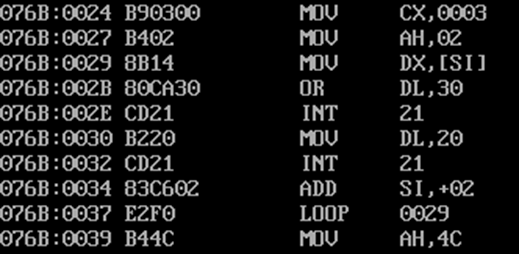
As can be seen from the figure, the jump displacement of loop s1 instruction is - 16, which is obtained by subtracting the first byte address (076B: 0029) after loop s1 instruction from the address (076B: 0039) at s2 label. For CPU, the displacement is expressed in the form of complement.
③ Attach the disassembly screenshot of debugging observation in debug during the above analysis.
A: the disassembly screenshots are shown in the screenshots given in question ① and question ②.
Experimental task 2
- The source code of task2.asm is as follows:
1 assume cs:code, ds:data 2 3 data segment 4 dw 200h, 0h, 230h, 0h 5 data ends 6 7 stack segment 8 db 16 dup(0) 9 stack ends 10 11 code segment 12 start: 13 mov ax, data 14 mov ds, ax 15 16 mov word ptr ds:[0], offset s1 17 mov word ptr ds:[2], offset s2 18 mov ds:[4], cs 19 20 mov ax, stack 21 mov ss, ax 22 mov sp, 16 23 24 call word ptr ds:[0] 25 s1: 26 pop ax 27 28 call dword ptr ds:[2] 29 s2: 30 pop bx 31 pop cx 32 33 mov ah, 4ch 34 int 21h 35 code ends 36 end start
- The screenshot of the debugging result interface is as follows:
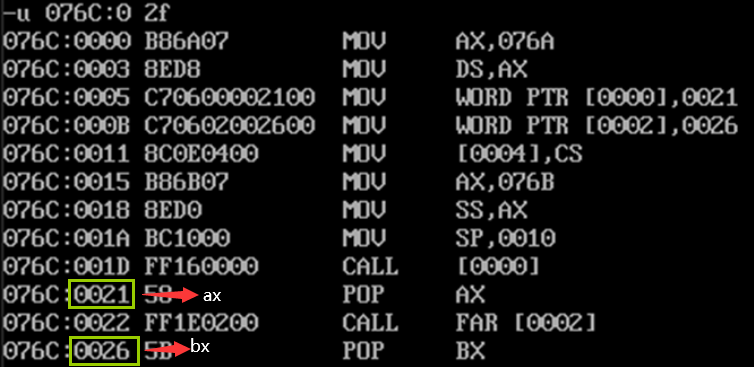

- Question answer:
① Q: according to the jump principle of call instruction, first analyze theoretically that before the program executes to exit (line31), register (ax) =? Register (bx) =? Register (cx) =?
A: theoretically, before the program is executed to exit (line31), register (AX) = the offset address of the first byte after call S1 instruction, register (BX) = the offset address of the first byte after call S2 instruction, and register (Cx) = the address of CS segment.
② Q: assemble and link the source program to get the executable program task2.exe. Use debug to observe and verify whether the debugging results are consistent with the theoretical analysis results.
A: from the screenshot of the debugging result interface given above, it can be seen that the debugging result is consistent with the theoretical analysis result.
Experimental task 3
The program source code task3.asm is as follows:
1 assume cs:code, ds:data, ss:stack 2 3 data segment 4 x db 99, 72, 85, 63, 89, 97, 55 5 len equ $- x 6 data ends 7 8 stack segment 9 dw 8 dup (0) 10 stack ends 11 12 code segment 13 start: 14 mov ax, data 15 mov ds, ax 16 mov ax, stack 17 mov ss, ax 18 mov sp, 16 19 20 mov di, 0 21 mov cx, 7 22 s: mov al, ds:[di] 23 mov ah, 0 24 call printNumber 25 call printSpace 26 inc di 27 loop s 28 29 mov ah, 4ch 30 int 21h 31 printNumber: 32 mov bl, 10 33 div bl 34 mov bx, ax 35 or bx, 3030h 36 mov ah, 2 37 mov dl, bl 38 int 21h 39 mov ah, 2 40 mov dl, bh 41 int 21h 42 ret 43 printSpace: 44 mov ah, 2 45 mov dl, ' ' 46 int 21h 47 ret 48 code ends 49 end start
The screenshot of running test is as follows:

It can be seen that the program successfully realizes the functions required by the experiment.
Experimental task 4
The program source code task4.asm is as follows:
1 assume cs:code, ds:data, ss:stack 2 3 data segment 4 str db 'try' 5 len equ $ - str 6 data ends 7 8 stack segment 9 dw 8 dup (0) 10 stack ends 11 12 code segment 13 start: 14 mov ax, data 15 mov ds, ax 16 mov ax, stack 17 mov ss, ax 18 mov sp, 16 19 mov ax, 0b800h 20 mov es, ax 21 22 mov bh, 0 23 mov bl, 2 24 call printStr 25 26 mov bh, 24 27 mov bl, 4 28 call printStr 29 30 mov ah, 4ch 31 int 21h 32 printStr: 33 mov ah, 0 34 mov al, 160 35 mul bh 36 mov di, ax 37 38 mov cx, len 39 mov si, 0 40 41 s: mov al, ds:[si] 42 mov es:[di], al 43 mov es:[di+1], bl 44 add di, 2 45 inc si 46 loop s 47 48 ret 49 code ends 50 end start
The screenshot of running test is as follows:

It can be seen that the program successfully realizes the functions required by the experiment.
Experimental task 5
The program source code task5.asm is as follows:
1 assume cs:code, ds:data 2 3 data segment 4 stu_no db '201983290186' 5 len = $ - stu_no 6 data ends 7 8 code segment 9 start: 10 mov ax, data 11 mov ds, ax 12 mov ax, 0b800H 13 mov es, ax 14 15 mov di, 0 16 mov cx, 2000 17 s: mov byte ptr es:[di+1], 17h 18 add di, 2 19 loop s 20 21 mov al, 160 22 mov bl, 24 23 mul bl 24 mov di, ax 25 mov cx, 80 26 s1: mov byte ptr es:[di], '-' 27 add di, 2 28 loop s1 29 30 mov bx, 80-len 31 mov di, ax 32 mov si, 0 33 mov cx, 12 34 s2: mov al, [si] 35 mov es:[di+bx], al 36 inc si 37 add di, 2 38 loop s2 39 40 mov ah, 4ch 41 int 21h 42 code ends 43 end start
The screenshot of running test is as follows:
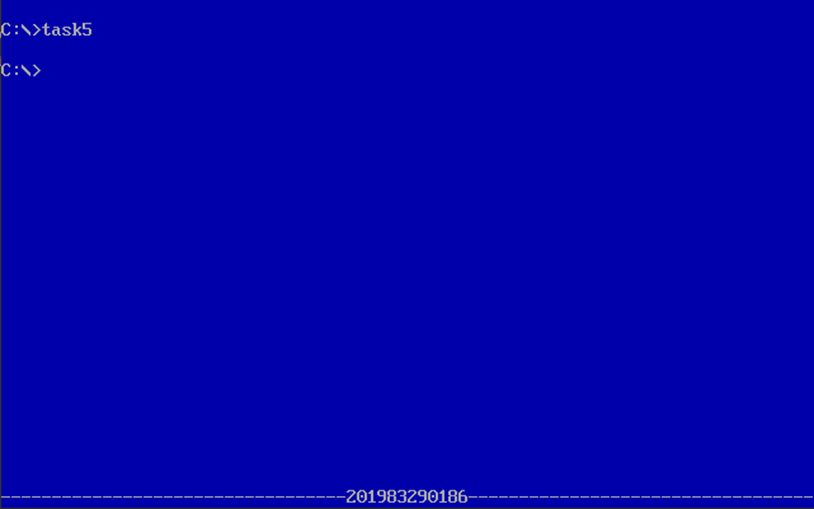
It can be seen that the program successfully realizes the functions required by the experiment.